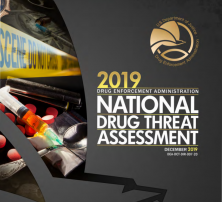
Annual report outlines strategic review of threats posed by drugs and drug traffickers
Source: Drug Enforcement Agency
February 3, 2020 (San Diego) -- Drug Enforcement Agency (DEA) Acting Administrator Uttam Dhillon has announced publication of the 2019 National Drug Threat Assessment, which outlines threats posed to the United States by domestic and international drug trafficking and by abuse of illicit drugs.
“This year’s report illustrates a shifting drug landscape in the United States,” said Acting Administrator Dhillon. “We’re pleased that in 2018, drug overdose deaths declined over four percent overall, with even greater decreases – over 13 percent – in overdoses from controlled prescription opioids. Many challenges remain, however, including the spread of fentanyl and methamphetamine across the country. DEA and its partners will continue to work diligently to combat the drug trafficking organizations that bring these deadly substances into our country and endanger the American people.”
“Unlike other cities, San Diego faces unique challenges by being on the U.S.-Mexico border,” said San Diego Special Agent in Charge John W. Callery. “In 2018, the DEA San Diego seized record amounts of methamphetamine and deadly fentanyl. While our battle with the Mexican drug cartels persists, our agents are more committed than ever to stemming the flow of these deadly drugs entering our community and effecting the lives of our friends and families.”
Illicit drugs, and the criminal organizations that traffic them, continue to represent significant threats to public health, law enforcement, and national security in the United States. As the National Drug Threat Assessment describes, the opioid threat continues at epidemic levels, affecting large portions of the United States. Meanwhile, the stimulant threat, including methamphetamine and cocaine, is worsening and becoming more widespread as traffickers continue to sell increasing amounts outside of each drugs’ traditional markets.
2019 National Drug Threat Assessment findings of note pertaining to San Diego:
- The Sinaloa Cartel and Jalisco New Generation Cartel (CJNG) are the most dominant Mexican Transnational Criminal Organizations (TCO) affecting the San Diego region. Both Sinaloa Cartel and CJNG control the Tijuana/San Diego trafficking corridor.
- Gang activity in San Diego shows poly-drug gang associates transport and sell anything that will generate a profit. At the retail level, gang members primarily sell methamphetamine, heroin, and marijuana. The trafficking of marijuana and pills, both diverted and counterfeit oxycodone, has increased, due to higher profit margins than methamphetamine and heroin.
- While heroin availability in San Diego is moderate, fentanyl availability is high and increased in San Diego and across the majority of the United States in 2018, highlighting the rapid spread of the drug. Fentanyl remains the primary driver behind the ongoing opioid crisis. Increases in fentanyl-containing counterfeit pills demonstrates traffickers’ continued efforts to expand the fentanyl user base.
- Methamphetamine availability in San Diego is high. Mexican TCOs continue to be the primary producers and suppliers of low cost, high purity, high potency methamphetamine in the United States. Mexican TCOs regularly produce large quantities of methamphetamine, which has led to a significant supply of methamphetamine in the U.S. market. The majority of Mexican TCOs are involved in methamphetamine trafficking, which has led to increased competition among the different TCO groups, TCOs exploring new markets for methamphetamine, and increasing quantities coming across the Southwest Border. The price of methamphetamine may begin to rise with a market expansion, although currently, prices in established markets remain consistently low.
- Cocaine was less available in the San Diego region than in the previous year. Cocaine consumption by minors in San Diego used to be infrequent but now has become more mainstreamed and even “normalized.”
The National Drug Threat Assessment provides a yearly assessment of the many drug abuse and drug trafficking challenges local communities face. Highlights in the report include usage and trafficking trends for drugs such as prescription drugs, heroin, methamphetamine, cocaine, marijuana and the hundreds of synthetic drugs. New to this year’s assessment is an expanded section on gangs - including street gangs, prison gangs, and outlaw motorcycle gangs – which now details gang activity geographically by DEA field division.
The assessment factors in data from many sources, including drug seizures, drug purity, laboratory analyses, information on the involvement of organized criminal groups, and survey data provided to DEA by state and local law enforcement agencies across the country.
The National Drug Threat Assessment can be accessed at https://go.usa.gov/xdjnt .







Recent comments